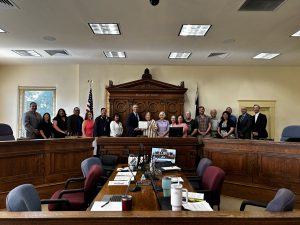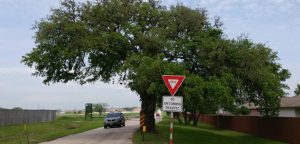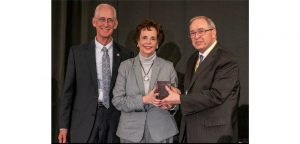Preserving history is an important American tradition. Understanding the significance of a homestead, cemetery, courthouse or other location helps residents be more connected to their community. It also provides the context for many of the happenings in the region’s history.
One task of the Hays County Historical Commission is to document those places in the county that meet the criteria for historical preservation. In most cases, the commission also works to have those locales put on the national historic registry.
Kate Johnson, president of the Hays County Historical Commission, lent us some ideas for the most prominent markers in the county. We also listed a few off the beaten path.
So if you find yourself tired of the usual summer events, jump in your car and grab a map of Hays County historical markers and hit the trail.
Note: In some cases, the original structure is no longer on the site, but you can read about why the locale is historically significant on the commission’s website.
We also downloaded two smart phone apps: Texas Markers ($.99) and Texas Historical Markers (free). Both were relatively easy to use, but the GPS appears to be just slightly off in several cases. Regardless, the apps are good for on-the-go convenience. It’s history in the palm of your hand.
Buda
Antioch Colony
Located between CR 142 and 148 on FM 1626 (near intersection of FM 967) in Buda, the Antioch colony was a rural farming community formed after the Civil War by a group of formerly enslaved African Americans. Although freed from slavery after the Civil War, African Americans still found it difficult to purchase land. In 1859, Anglo businessman Joseph F. Rowley purchased 490 acres in north Hays County, along Onion Creek. He began selling parcels to former slaves in 1870 at $5.00 per acre. There are historical markers at the Old Antioch Church and the Antioch Cemetery.
Onion Creek Post Office and Stagecoach House
Located in Buda at 109 North Loop 4, this historic site sits on a bluff above Onion Creek. The post office was established in 1875, but a stone lintel with the date of 1876 shows the building was completed that year. The adjacent Severn stagecoach house, believed to have been built in the mid-1870s, was recently renovated and now houses Buda’s tourism department. Early Anglo settlers in the area reported finding arrowheads and stone tools around sections of Onion Creek close to this historic site, which may indicate that Native Americans once inhabited the area.
Buda United Methodist Church
Buda Christian Church
First Baptist Church of Buda
Dripping Springs
Dr. Pound Pioneer Farmstead Museum
This Dripping Springs museum is located at 570 Founders Park Road in Hays County. Offering guided tours, the museum also hosts a number of events such as Pioneer Day: a Celebration of Early Texas Life. Named after Joseph M. Pound, who first came to Texas in 1847 to fight in the war against Mexico, the museum sits on the farmstead of one of Dripping Springs’ founding families and is rich in Texas history. The Pound farmstead has been restored from its original two log cabins with a center breezeway. Visitors are welcome to see and live the rural life of a Central Texas pioneer with the renovated barn, smokehouse, windmill and garden areas. Left, a young girl learns how to make cornmeal at one of the farm’s Time Travel Thursdays.
Dripping Springs United Methodist Church
Marshall-Chapman Home
First Baptist Church of Dripping Springs
Dripping Springs Academy
Kyle
John Wheeler Bunton
Located at the Old Kyle City Hall (corner of Burleson and Center Sts.), this historical marker serves as a reminder of the life of John Wheeler Bunton. A Texas pioneer, Bunton was born in Sumner County, Tenn., and migrated to Texas in 1833. He signed the Texas Declaration of Independence, helped draft a constitution and fought in the Siege of Bexar and the Battle of San Jacinto. A lawyer, rancher and landowner, Bunton served in the 1st and 3rd congresses of the Republic of Texas. He called Austin and Bastrop County home before settling in Hays County near Mountain City. Originally buried in Hays County, he was reinterred in the State Cemetery in Austin in 1932.
Kyle Auction Oak
Located at 204 Sledge Street in downtown Kyle, the Auction Oak is the site of the famous 1880 auction in which land lots were sold when Kyle was founded along the international and great Northern Railroad. Under the shade of the heritage oak tree, the public auction was held and all business as well as most residential lots were sold. The tree, now more than 300 years old, is maintained by the Hays County Historical Commission. (Note: Next door is the marker for the Cora Jackman Donalson House, though no information is available about its history on the Texas Markers app.)
Claiborne Kyle Log House
This is the original homestead of Claiborne Kyle, one of the first settlers in the area. The town is named for his son, Fergus Kyle, who was also a state legislator. The home is open the first Sunday of each month April – September. There are also two events annually: Blooms over the Blanco in April and the locally popular Fried Chicken Dinner in September. The chicken dinner (which is actually lunch) is one of the primary fundraisers for the home.
Kyle has seven historical markers downtown within walking distance from each other
San Marcos
The Calaboose African American History Museum
Located at 140 MLK Drive in San Marcos, the African American History Museum is home to artifacts and memories of the city’s African American past. Among the displays are a local black history showcase and an exhibit on the Buffalo Soldiers that aided in settling the Texas frontier and who also fought in the Civil War. Johnnie Armstead founded the museum about nine years ago. The museum offers guided tours, self-guided tours, traveling trunks, classes, school tours, films, demonstrations, living history programs, hands-on children’s activities, lectures and accommodations for disabled visitors. Call (512) 353-0124 for tours by appointment.
San Marcos Cultural Center
The Mission of Centro Cultural Hispano de San Marcos (CCHSM) is to serve as a community beacon for the preservation, development, promotion and celebration of the Hispanic arts, culture, heritage and values.
Farmers Union Gin Company
The Farmers Union Gin Company in San Marcos dates back to the early 1900s when it was purchased by local farmers Henry Kellerman, J.H. Barbee, A.H. Fleming, I.B. Rylander and J.H. Williams in 1908. Located on Grove Street, the Farmers Union Gin Company was established under the leadership of Oscar Calvin Smith and was the first industrial plant of its size in San Marcos. The gin became vital to the area’s cotton industry during this time period, remaining in operation until 1966. Built in 1911, the brick gin house replaced an earlier structure, which burned. The building became home to Texas Red’s steak house from 1991 until 2004 when it was again destroyed by fire.
The Hays County Courthouse
Built in 1908, the Hays County Courthouse is located in San Marcos and stands three stories high made of Elgin brick. A historical site of Central Texas history, this old courthouse sits on a rusticated brick base with a nine-foot statue of the Goddess of Justice atop the dome roof. The ornate architecture by the courthouse’s architectural firm, C.H. Page and Bros., in the style of Renaissance Revival with Beaux Arts influences is a site to see. The courthouse is open 10 a.m. to 2 p.m. on the first and third Saturday each month for historic tours. The Hays County Historical Commission also offers private tours by appointment. Call (512) 393-2277 for more information.
Wimberley
James C. Lane House
Built in 1935, this historic house was constructed by Wimberley builder James Calvin Lane next to a café run by his wife, Rebecca. Lane went on to build a two-story home and a bigger café on the square in Wimberley. Rebecca operated the first telephone switchboard in Wimberley in their home’s living room. The craftsman style exterior of the home is made of native rock and poured concrete, decorated with smaller pieces of petrified wood, rock and fossils.
John R. Dobie House
Built in 1892, this house was purchased by John R. and Martha Dobie in 1899. Dobie, a Scotland native, was a farmer, rancher and Hays County Commissioner from 1897-1898. The home is an example of the vernacular style featuring a central hall plan, board and batten construction and classical detailing. It remained in the Dobie family until 1977. Today it houses several doctors and other medical professionals.
The Century-Old Wimberley Cemetery
On land first patented to Amasa Turner in 1847, settlers constructed a log cabin which first served as a church and school. Circuit riders conducted the services. When Melissa Wimberley, the young daughter of Pleasant Wimberley, died in 1876, she was buried on the church grounds. John H. and Callie Saunders bought the property in 1885. They donated one acre of land for a community cemetery. Additional land was later donated by the family of John R. Dobie. Buried in the cemetery is W.W. Moon, who was the first permanent settler in Hays County.
Wimberley has five historical markers downtown within walking distance from each other










